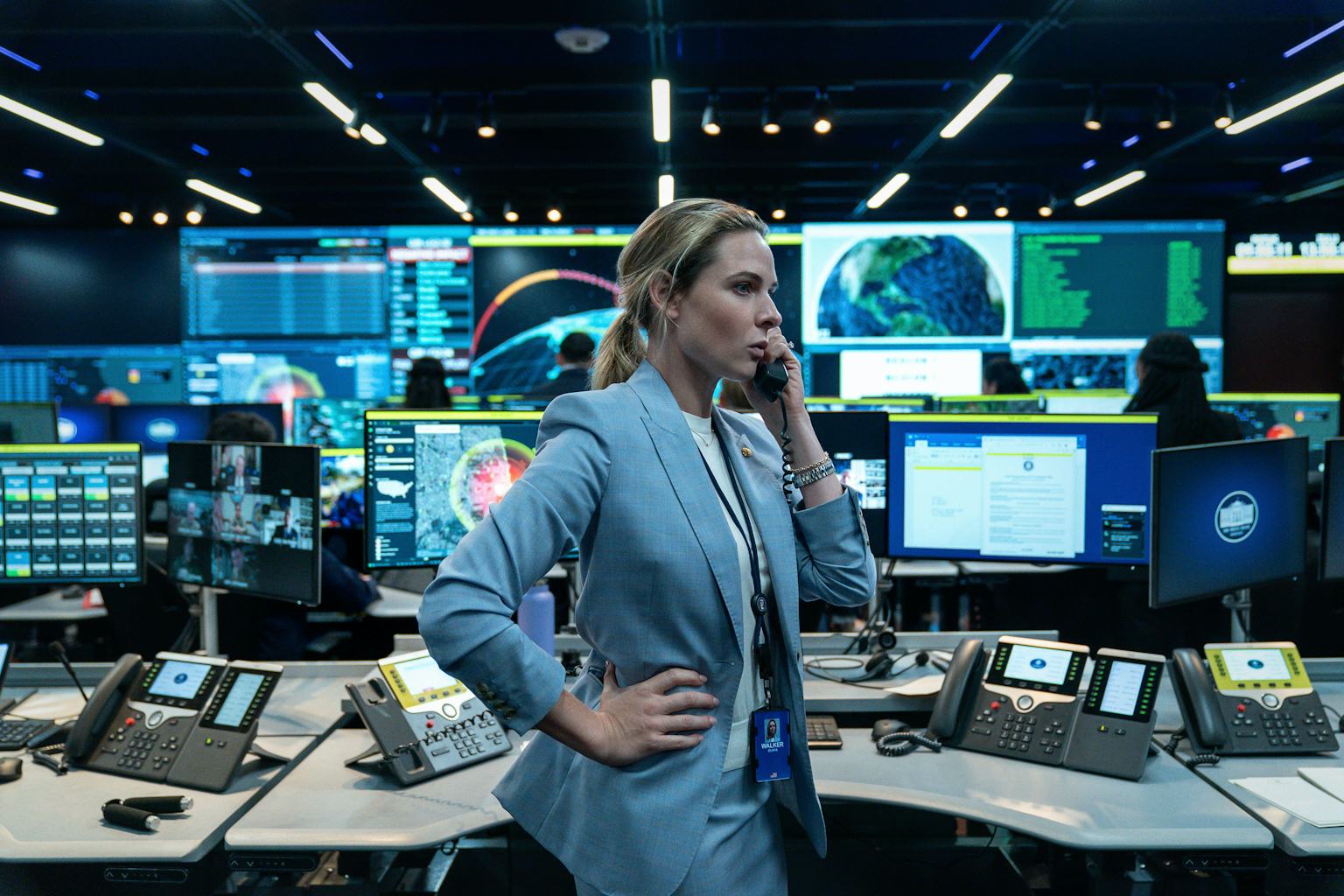
Rebecca Ferguson as the oversight officer for the White House Situation Room in A House of Dynamite. Landmark Media / Alamy
As a teenager in the 1980s, I was shown a BBC drama in school called Threads that depicted the impact of a nuclear strike on a city in northern England. Threads is a brutal vision of a terrifying reality that I imagine haunted many people in the years before the end of the cold war.
For younger generations who have so far experienced a world with pandemic lockdowns, wars in Ukraine and Gaza, and international tensions that make a third world war no longer feel like a fictional scenario, geopolitical fear and anxiety is again hard to escape. And now we have a film showing us how a nuclear war could begin.
From three different perspectives, Kathryn Bigelow’s new Netflix thriller, A House of Dynamite, shows us how officials in the US might respond if it looked like a nuclear strike was imminent. Each perspective reveals a different element in the horror and complexity of the situation, as officials work to determine who is responsible and how to manage the attack.
Central to this complexity is the sense of what Prussian general and philosopher of warfare Carl von Clausewitz described as the “fog of war”. This term was devised to describe the uncertainty and chaos of the battlefield in 19th-century wars, but it is applicable to the traumatic situation policymakers find themselves thrown into in A House of Dynamite.
The fundamental problem for all of the officials in the film is that they lack certainty on the origin of the attack. Was the missile launched by Russia, China or North Korea – or could it be Russia manufacturing uncertainty so the US thinks it was North Korea? The question then moves on to whether North Korea even has the military or technical capability to launch such an attack.
With a strike on Chicago looking increasingly certain, officials soon begin to grapple with how the US should respond. The president is shown the “nuclear football”, which allows him to authorise a retaliatory nuclear strike. And his aide takes him through a menu of responses, with each labelled “rare”, “medium” or “well done”.
The president, played by Idris Elba, is shocked by the absurdity of the strategic language and concepts – as much of the audience will be too. The film shows the personal horror that is felt by people having to take decisions that make the scenarios and simulations they trained for real.
Some officials suggest waiting to see what happens before responding. As a security council staff member remarks, there’s always a chance the warhead could malfunction upon impact. Others say the strike might be a test to see how the US responds – and thus a precursor to something far worse. The dilemma facing US leadership, the security council staffer says, is “surrender or suicide”.
The film’s opening credits imply that a nuclear strike on the US is not a far-fetched scenario, telling us that the era when world leaders wanted a planet with less nuclear weapons “is now over”. But how far are we from this terrifying situation becoming a reality?
One of the most controversial issues in the film is why North Korea, Russia or China would take a course of action that would result in retaliation so severe that it could leave their territories as apocalyptic wastelands. China and Russia, in particular, appear far more comfortable in today’s complex world of overlapping alliances and economic entanglement than many western countries.
The North Korea expert in the film, Ana Park, explains that Pyongyang possibly could afford to risk launching a strike on the US because of its defensive systems. But the belief of a regime that it could survive retaliatory responses from the US and its allies is almost certainly wishful thinking – no matter how sophisticated those defences are.
It’s also not clear whether any leader, regardless of the type of regime, would actually be able to embark on this course of action. Military generals, for example, might intervene. And perhaps most importantly, current assessments suggest that North Korea does not have the capabilities to launch an attack resembling the one portrayed in the film anyway.
Command and control
Another element in the film is the focus on how an attack on the US would involve disrupting the “command and control” structures of the state. US officials raise concerns that its communication and surveillance systems may have been sabotaged by hackers and AI tools, leaving them in a situation where they lack crucial intelligence about the attack and are unable to trust the information they are receiving.
In this sense, A House of Dynamite gives a convincing insight into the mix of tactics that could be used in a complex global crisis in the 21st century. Sabotaging the tools used to make communication faster, and “situational awareness” more detailed and granular, is likely to be a major method for sowing uncertainty and confusion in the years ahead.
In this age of hybrid warfare – which involves methods to disrupt and sabotage an opponent’s activities without engaging in open hostilities – part of the problem is uncertainty about who is doing what. This has been evidenced in the drone disruption and cyber-attacks we have seen across Europe in 2025.
Another issue is unease over what might be possible in the future, when the rapid pace of technological change is constantly introducing new forms of sabotage, disruption and destruction.
A House of Dynamite gives an insight into the uncertainty of security and defence in times of hybrid war. But the more immediate strategic dilemma policymakers face in the film – how to respond to a nuclear attack – is probably not an imminent geopolitical reality.![]()
Mark Lacy, Senior Lecturer, School of Global Affairs, Lancaster University
This article is republished from The Conversation under a Creative Commons license.


Leave a Reply